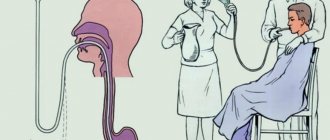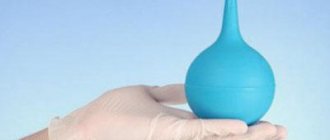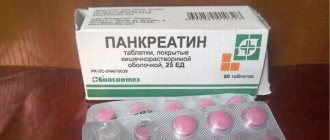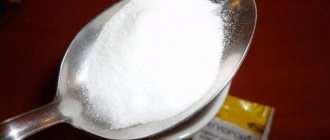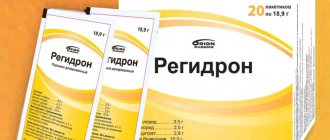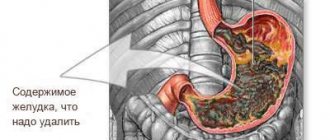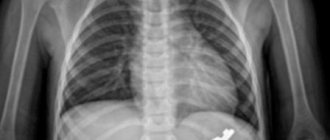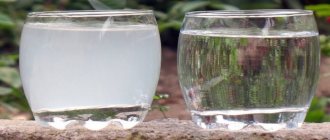In case of poisoning of various kinds, gastric lavage is required immediately. But the ambulance can take a long time to travel, and in these situations time passes by seconds and if you don’t make it in time, then even death is possible. For this reason, you need to know how to rinse your stomach at home. This procedure will help not only restore the functioning of the food system, but also greatly improve the patient’s condition.
Gastric lavage at home may be necessary at any time.
When should you rinse your stomach?
Gastric lavage in adults and children is the first procedure to begin providing medical care for poisoning. Dangerous compounds and bacteria, having penetrated the stomach, are not absorbed immediately. They just stay in the cavity for some time.
Washing allows you to free the body from them, prevent harmful substances from entering the blood and prevent the development of serious disorders in the functionality of internal organs. It must be remembered that such a procedure is medical and has indications and contraindications. In what situations is it possible to cleanse the stomach using this method?
Indications:
- Overdoses caused by food, mushrooms, medications, and alcoholic beverages.
- Narrow outlet of the stomach.
- In situations in which the tone of the muscle tissue of the digestive organs is reduced.
- Intestinal obstruction.
- Penetration of dangerous compounds into the lumen of the stomach in chronic pathologies.
Rinsing for food poisoning can be done at home, but not always. Before the procedure, you need to consult a doctor. For some pathologies, such cleansing is unacceptable.
Contraindications:
- in case of poisoning with acids, alkalis, cauterizing poisons,
- presence of bleeding from the stomach or esophagus,
- serious disturbances in the functioning of the heart muscle,
- lack of consciousness in the patient,
- the presence of convulsive manifestations,
- problems with blood circulation in the brain,
- narrowing of the esophagus of an organic nature.
In such situations, gastric lavage is prohibited. The process is dangerous to the patient’s health and can cause a deterioration in the condition. In case of poisoning with acids and alkalis, cleansing is carried out only in the hospital. Self-washing at home will cause repeated burns of the mucous membrane.
Main features
The main indication is poisoning. A person can become poisoned either accidentally or intentionally for the purpose of suicide.
- Food poisoning. A short time after eating low-quality food, a person feels unwell: abdominal cramps, nausea, severe weakness, cold sweat, and possibly vomiting.
- Alcohol poisoning. A person can feel unwell both when taking large doses of regular alcoholic drinks and when taking low-quality alcohol or surrogates (methyl alcohol). Alcohol is absorbed fairly quickly, but if you take timely measures, it is possible to alleviate the condition and avoid consequences.
- Poisoning with acids and alkalis. They can drink them either by mistake or for the purpose of suicide. In everyday life, this is most often acetic acid, various cleaners and household chemicals.
- Poisoning from tablets or other dosage forms. It can also be intentional or accidental. Accidental drug poisonings occur most often in children. Older people may mistakenly overdose on prescribed medications. Here, timely gastric lavage can save lives.
- Mushroom poisoning. It also refers to food poisoning, but still has its own characteristics: it can be much more severe, since some mushrooms produce strong toxins.
- Stagnation of food in the stomach due to decreased contractility of its walls or impaired digestion. This happens with gastritis, deformities of the outlet, and diseases of the nervous system. Especially pronounced after heavy meals.
At home, it is prohibited to add any medications, herbal decoctions or potassium permanganate to the water for washing the gastric cavity. Cleaning should be done with clean water.
Remember that only a doctor can accurately choose what to rinse your stomach with. At the pre-medical stage, only plain water can be used.
In case of poisoning with acids or alkalis, gastric lavage is carried out by doctors from the ambulance team. To do this, they use a gastric tube through which water is poured in and out.
With this cleaning, you can prevent repeated contact of the mucous membrane of the esophagus and oral cavity with aggressive alkalis and acids. These substances cause chemical burns or necrosis of the walls of the esophagus, and they can also damage the lungs and trachea if the chemicals are thrown into the respiratory tract.
After washing the gastric cavity through a tube, the victim is hospitalized in a hospital, and subsequent treatment is prescribed by doctors from the hospital.
Food poisoning is a digestive disorder that is associated with the consumption of toxic or low-quality food. The main symptoms (signs) are:
- cramps, pain, bloating and pain in the abdomen;
- nausea, vomiting (may be repeated);
- stool disorder;
- weakness, headache, dizziness, darkening of the eyes, lethargy, increased heart rate;
- chills, fever up to 39 °C or more.
Trouble can happen outside the home: in nature, in the country, in the field. What should I do to rinse my stomach? In case of poisoning, you can use ordinary water. Preferably boiled, 2-4 liters. You can add a little soda or salt to it. So, you need to perform the following algorithm:
- Give the patient 3 to 5 glasses of liquid to drink, then press on the root of the tongue. This usually causes vomiting.
- Repeat the procedure until clean water comes out during emptying.
- With diarrhea, the body loses a large amount of water, so the victim must be given a warm drink.
- Be sure to use sorbents - drugs that remove toxins. These include activated carbon. 1 tablet is used per 10 kg of body weight. A person weighing 70 kg should take 7 tablets.
- If the victim has chills, he should be wrapped up and allowed to sleep.
- After poisoning, depending on the severity of the case, it is necessary to adhere to a strict diet: from completely refusing food to eating crackers, jelly and water-based porridge the next day. A gentle diet should last at least a week.
First of all, you need to familiarize yourself with the indications and contraindications for rinsing.
- the presence of seizures, before washing the patient must be given an anticonvulsant medication;
- presence of open bleeding in the stomach or esophagus;
- damage to the mucous membrane of the throat, esophagus;
- heart attack or stroke;
- a person being unconscious;
- absence of a swallowing reflex during testing;
- narrowing of the esophagus.
If there are contraindications, it is not recommended to perform gastric lavage on your own in case of poisoning, in order to avoid causing even greater harm.
Methods of gastric lavage
There are several methods of gastric lavage. The technique is chosen depending on the poisoning and the patient’s condition.
Techniques:
- Without the use of a probe, the second name is the “restaurant” method, often used for poisoning with alcohol and its surrogates (methyl alcohol). This is done with the help of a large volume of water and self-provoking vomiting.
- Using a thick probe.
- Using a thin probe.
All methods require attention and accuracy. If washing is carried out incorrectly, the development of negative consequences and complications is possible. Each method is carried out carefully following the instructions.
How to properly perform gastric lavage. Each technique has certain specifics.
When should colonic lavage be done?
The technology can be used for preventive purposes to rid the body of waste and toxins. But most often, intestinal cleansing is performed for various poisonings. Manipulations will be necessary in case of intoxication of the body with low-quality products (or stale ones). And also, if a person is poisoned by chemicals, various acids or laundry or dishwashing detergents.
Colon hydrotherapy is used for alcohol intoxication or taking a large number of medications. Poisoning with various poisons and drugs is considered the most dangerous. If this happens, then it is urgent to provide the patient with first aid and rinse.
Restaurant gastric lavage method
This method is used in a situation where the patient is unable to swallow the tube, but can drink liquid on his own. To rinse, you will need at least five liters of water. A person drinks half a liter and provokes vomiting.
Required:
- Wash solution. There are several liquids that can be used during the procedure.
- Clean water, preferably boiled, but not hot or cold. Medium-temperature liquid will not provoke accelerated absorption or spasmodic manifestations in the stomach.
- Saline solution - take a couple of large spoons per five liters of water. This remedy reduces the rate of absorption of toxic compounds and prevents them from moving into the intestines.
- A weak solution of potassium permanganate should be light pink. The liquid is thoroughly mixed and filtered through gauze to eliminate the presence of substance crystals that can cause a burn to the gastric mucosa. Gastric lavage with potassium permanganate helps get rid of bacteria and infections.
- It is also allowed to use a soda solution to wash the house. Two large spoons of powder are diluted in five liters of water and mixed thoroughly.
- When carrying out probeless rinsing, you will need a container into which the released water is collected. After cleansing the stomach, it is necessary to show them to a medical professional to make an accurate diagnosis.
- The person who will be doing the washing will need gloves, an apron or a robe. Vomit may contain toxins that are hazardous to health and may help (E. coli, viruses).
Having prepared the necessary means, you can begin rinsing. The procedure is performed according to a certain scheme. How to properly cleanse the stomach of poisons?
Scheme:
- The patient is seated so that the head is lower than the body. This will help prevent vomit from entering your respiratory tract.
- Install the container.
- Wear protective equipment.
- The injured patient is given five hundred milliliters of solution to drink.
- If there is vomiting, the head of the poisoned person is tilted and held over the container.
- If spontaneous vomiting is absent, then it is induced artificially by pressing on the root of the tongue.
- Purification is repeated until the effluent waters are completely cleared.
Gastric lavage with this method does not help to completely remove toxins, so it is better to choose it if it is impossible to use tubes. Caution is required and close monitoring of the patient's position to prevent choking on vomit.
How is the procedure performed?
- The poisoned person is seated on a chair or laid on his side. Pour water or rinsing solution into a glass and drink. You need to drink 2-3 glasses at one time, and do this in a short time (3-5 minutes). Rapid filling of the stomach with a large volume of liquid will in itself cause a reflex spasm of its walls and vomiting.
- If vomiting does not occur on its own, you need to induce it. To do this, press with a spatula or fingers on the root of the tongue.
- It is better not to throw out the first portions of vomit; they may be needed for analysis and establishing the cause of poisoning.
The procedure will need to be repeated several times. How many times should you wash your stomach if you are poisoned? There is no clear answer here. Ideally, until clean water, without any impurities, begins to come out along with vomiting. This usually requires 3 to 5 liters of liquid.
Using a thick probe
A thick probe is a rubber tube that can reach a meter in length and a diameter of up to thirteen millimeters.
One of the ends is cut off, the other is rounded and has side holes. What you will need:
- Probe.
- Wash solution. The liquids described above are used. But it is necessary to correctly calculate the amount administered - up to seven milliliters per kilogram of the patient’s weight.
- Funnel and mug.
- Protective equipment for the person performing the washing.
- Container for collecting rinsing water.
- Cloth or towel.
- Glycerin, you can use Vaseline.
How to do it:
- The use of a probe is allowed only if the patient is conscious and understands what is happening.
- The person is correctly positioned on a chair in a sitting position. It is permissible to perform a similar procedure on a bedridden patient, but he must lie on his side.
- The poisoned person is covered with a towel.
- It is necessary to clarify the length of the inserted probe. It is equal to the sum of the distances from the mouth to the earlobe and from the ear to the lower edge of the xiphoid process. The resulting indicator is marked on the tube in order to know exactly how much it is permissible to insert it inside.
- Before gastric lavage, it is necessary to explain to the poisoned person about the possible discomfort when inserting the tube.
- The round tip is lubricated with glycerin or petroleum jelly, and protective equipment is put on.
- The end of the probe is placed on the patient's tongue and asked to make several swallowing movements, while gradually moving the tube inward. If necessary, an assistant will be needed to carry out the procedure.
- After insertion, it is necessary to check whether the probe has actually reached the stomach. If the tube is lowered below the level of the organ, gastric contents should appear.
- A funnel is attached to the device and half a liter of solution is poured into it, held at the level of the stomach.
- Gradually, the tube begins to be lifted so that the water goes inside. When there is no liquid left, the funnel is lowered to the level of the stomach, and the outflow of the organ’s contents will begin. The resulting water is sent for testing.
- The procedure is carried out until complete purification and clean water comes out.
Such cleansing is carried out carefully and carefully. It is necessary to correctly calculate the volume of injected solution in order to avoid negative consequences.
What to do after washing
The patient should be immediately placed on the bed, and a heating pad with hot liquid should be applied to the legs. This will help eliminate spasms and chills. In this case, you need to lie on your side for 30-40 minutes, during this period the nausea will pass. If vomiting no longer occurs, then sorbents can be given:
- Enterosgel;
- Activated carbon;
- Polysorb.
These remedies will help cleanse the stomach of toxins and restore the mucous membrane. About half an hour after taking these medications, the patient should be given a cup of strong coffee or sweet tea; these drinks have a calming effect on the nervous system. Then you need to go to bed and call an ambulance. Doctors will conduct a full examination and prescribe the necessary treatment.
Additionally, it is recommended to take a sorbent, for example, Enterosgel
Thin tube for gastric lavage
Rinsing with a thin probe differs from the previous one in that it is carried out not only through the oral cavity, but also through the nasal passages. The procedure requires the same components and a Janet syringe; you also need a glass of water and a straw; the cleansing algorithm is slightly different.
How to do it:
- The patient must be aware of what is happening.
- A thin probe is inserted through the mouth or the freest nasal opening. The distance is measured as follows - from the tip of the nose to the earlobe and down to the edge of the xiphoid process.
- The patient should be in a high position.
- The tip of the probe, lubricated with Vaseline, is inserted into the nasal opening at a distance of up to 18 centimeters, the patient’s head is tilted forward and the insertion is continued.
- After inserting the probe, you need to make sure that the patient is able to breathe and talk freely.
- The rinsing liquid is injected into the probe using a Janet syringe, and the vomitus is also pumped out with it.
- The result obtained is placed in a container and transferred to doctors for examination.
- Lavage is done until the stomach is completely cleansed of harmful compounds.
It is necessary to carry out such a procedure carefully and monitor the patient’s behavior. Proper cleansing will speed up the healing process.
Indications
The procedure is carried out with the aim of improving a person’s well-being, suppressing symptoms and reducing the risk of complications. It is necessary in the following situations:
- acute food poisoning;
- drug overdose;
- alcohol intoxication, hangover;
- use of dangerous chemical compounds, surrogates (methyl alcohol);
- propagation of infection;
- intestinal obstruction;
- entry into the digestive tract of heavy metal salts.
The listed pathologies are encrypted, the ICD code is T36-T50. The event is also of particular importance during emergency diagnostic testing (FGDS), hospitalization in the intensive care unit and in the process of preoperative preparation.
Previously, the organ was cleansed when overeating. Now, if such a condition does not affect a person’s health in any way, this manipulation is not necessary; it is easier to use enzymatic preparations and control the amount of food consumed in the future.
Gastric lavage in children
It is recommended that emergency gastric lavage in children be entrusted to medical personnel and carried out in a hospital.
There are some features of such a procedure. Peculiarities:
- The diameter of the probe depends on the age of the child. It is unacceptable to use thick probes in children.
- To cleanse children, they require more reliable fixation, so it will be quite difficult to carry out the procedure alone.
- It is necessary to carefully calculate the volume of liquid that is injected inside. It depends on the age of the baby.
- It is recommended to carefully monitor the amount of solution introduced and output to avoid excess water entering the intestines.
For small children
Doctors in children's hospitals prefer to use tube technology, since the likelihood of vomit entering the respiratory tract is minimized. The “restaurant” method is also recommended for older children (from 2 years old) and teenagers.
What is necessary?
To carry out the event you need to prepare:
- nasogastric tube, the width and length of which are selected individually;
- pelvis;
- apron;
- gloves;
- disposable syringe;
- solution for cleansing the stomach (it is better to take soda or saline);
- napkins or towel;
- petrolatum.
The procedure in some cases is combined with hydrocolonotherapy (enema), if the patient is indicated for intestinal lavage, an Esmarch mug or syringe, magnesium is additionally used for this.
How to do it?
Place the baby on his side, secure him with his hands and a diaper. Prepare the probe according to the step-by-step instructions (see details above) and insert it through the nasopharynx. Pour in the product, the volume of which is calculated individually taking into account the baby’s age. Disconnect the end of the tube from the funnel and lower it into a basin to remove the solution with toxins and waste. Repeat stomach cleansing several times.
When stimulating the gag reflex, it is better for children to apply gentle pressure on the upper abdomen.
Possible difficulties and complications
When washing the stomach, unpleasant situations can often arise. In most cases they are easy to deal with.
Difficulties:
- The volume of water flowing out is less. This indicates possible penetration of the solution into the intestines or incorrect position of the probe. It is recommended to try changing the position of the probe - insert it deeper or pull it out a little.
- No liquid coming out. In such a case, you need to pull out the probe and see if it is clogged. Clean if necessary.
- The presence of bleeding or disruption of the breathing process requires immediate cessation of the procedure.
- During the procedure, damage to the vocal cords cannot be ruled out when the probe penetrates the larynx.
If during rinsing the patient experiences unpleasant symptoms or breathing problems, the procedure is stopped. Further actions and treatment are carried out by a medical professional, this will help avoid complications.
Further therapy and rehabilitation period
During the rehabilitation period, bed rest is necessary.
After the gastric lavage procedure, it is very important to continue treatment. Since some harmful substances could well remain in the body, attention should be paid to other methods of cleansing the gastrointestinal tract. In particular, a good effect is achieved by ingesting sorbents.
Also important for the patient is bed rest, a large amount of fluid consumed orally, and the absence of stressful situations. If poisoning is accompanied by a significant increase in temperature, even fever, then you must immediately call an ambulance. As soon as the victim’s condition returns to normal (a couple of days after the incident), you can start taking medications that normalize the intestinal microflora.
For any type of poisoning, it is advisable to call a doctor or make an appointment with him as soon as you feel better. Since some types of intoxication can develop within 1-2 days after the incident, it is important that the patient’s condition is monitored by a specialist. If the symptoms seem serious to the doctor, he may prescribe hospital treatment for the victim.
After poisoning, the patient is usually prescribed a fairly strict diet. Usually, all products that can cause irritation of the gastric mucosa are excluded from the menu. It is necessary to introduce dietary low-fat soups, porridges cooked in water, jelly, fermented milk products, etc. into the diet. Active physical activity is also extremely undesirable.
What mistakes should not be made?
Those who perform gastric lavage for the first time often make mistakes. What can be done wrong during the procedure?
Wrong:
- Lack of control over the volume of solution. Care must be taken to ensure that the amount of fluid injected and removed is the same. Excessive absorption is dangerous to health.
- Incorrect calculation of the solution used. A large volume leads to the transfer of toxins into the intestines.
- Failure to follow the rules when preparing medicinal solutions. Highly concentrated liquids cause burns to the mucous membrane.
- Self-cleansing for poisoning with alkalis, vinegar essence and other acids. Such actions are prohibited.
Gastric lavage at home is quite acceptable. However, the first aid procedure requires caution and attention. If the rules are not followed, the development of serious complications is possible. In children, it is better to entrust stomach cleansing to a doctor.
Doctors' advice: what not to do in case of alcohol poisoning
Those who perform gastric lavage for the first time often make mistakes. What can be done wrong during the procedure?
Wrong:
- Lack of control over the volume of solution. Care must be taken to ensure that the amount of fluid injected and removed is the same. Excessive absorption is dangerous to health.
- Incorrect calculation of the solution used. A large volume leads to the transfer of toxins into the intestines.
- Failure to follow the rules when preparing medicinal solutions. Highly concentrated liquids cause burns to the mucous membrane.
- Self-cleansing for poisoning with alkalis, vinegar essence and other acids. Such actions are prohibited.
Gastric lavage at home is quite acceptable. However, the first aid procedure requires caution and attention. If the rules are not followed, the development of serious complications is possible. In children, it is better to entrust stomach cleansing to a doctor.
- If a person is unconscious. He cannot swallow, you should not force water on him, he may choke.
- When there are signs of bleeding from the stomach: bloody vomiting or vomiting “coffee grounds.”
- If there is very strong “dagger” pain in the abdomen, as the ulcer may perforate.
- In case of poisoning with concentrated acids, alkalis, gasoline, turpentine. Here, only the probe method of rinsing is applicable, since inducing vomiting can provoke a re-burn of the esophagus. You should not try to rinse the stomach with soda in case of acid poisoning and vice versa, since the gas formed during the chemical reaction can cause perforation of the stomach walls.
- Impaired swallowing reflex, for example in patients with stroke or other diseases of the nervous system.
- During an attack of bronchial asthma.
- With convulsive syndrome.
- If there are heart rhythm disturbances, low blood pressure, suspicion of a heart attack.
- It is not advisable to rinse the stomach of small children at home; this is done only as a last resort (for example, the child has been poisoned by pills, the wait for an ambulance is long, and time is very valuable).
Clear water coming out of the stomach with vomiting does not always mean that the stomach has been completely washed out. A certain amount of toxins may remain in the folds of the mucous membrane, and some may have time to pass into the intestines.
After washing, it is advisable to give the patient a sorbent, that is, a substance that binds toxins and prevents them from being absorbed into the blood. This can be water with crushed activated carbon, enterosgel, polysorb, lactofiltrum.
In case of alcohol poisoning, you can give a glass of water with 5 drops of ammonia dissolved in it.
In any case, after poisoning, you need to drink more fluids, not for the purpose of washing, but for the purpose of detoxification - the rapid removal of already absorbed poison. For this we use clean water, electrolyte solutions (Regidron), or mineral water without gas.
If you feel well (for example, with mild food poisoning), you can stay home and call a doctor. You should refrain from eating any food for the rest of the day.
If symptoms persist - nausea, abdominal pain, diarrhea, fever, weakness, it is better to call an ambulance (if it has not been called before) and go to the hospital.
In the hospital, the gastric lavage procedure will be repeated, but this will be done with the help of a probe.
For a child over 3 years old, you can try to rinse the stomach in the usual way - give him water to drink and induce vomiting.
It is almost impossible for a small child to perform such a procedure at home. The main treatment for poisoning in such children is to induce vomiting.
In case of strong excitement, older children are restrained, infants and toddlers are swaddled.
Stimulate vomiting by reflex irritation of the root of the tongue. You can give your child 1-2 tablespoons of a concentrated salt solution to drink (2-3 teaspoons per glass of warm water). Drinks are given from a bottle with a nipple. You can try injecting it into your mouth in small portions using a syringe without a needle, carefully along the inner surface of your cheek.
Do not force liquid into the child, as it may enter the respiratory tract.
The ambulance team will begin to lavage the child's stomach through a tube at home. The simultaneously administered amount of liquid for rinsing a child is approximately the following: 50-100 ml in the first 6 months, 150 ml per year, the total amount for children under one year old is no more than 1 liter.
Children 2-5 years old are administered 200-300 ml at a time, the total amount is 2-5 liters. Typically, the calculation of the required fluid looks simplified like this: 1 liter for every year of life. For example, a 2-year-old child needs 2 liters for rinsing.
For children over 6 years old, the rinsing portion is 400-500 ml, the total amount is 6-8 liters.
You should strictly exclude coffee, which leads to dehydration. And also one should not allow a person to take a cold shower. When poisoning occurs, the body's temperature drops sharply, so hypothermia can occur.
Even after rinsing the stomach with water, a person may still experience nausea. This is natural, since alcohol is a nerve poison and disrupts blood sugar levels. Mint tincture, which can be purchased at any pharmacy, will help. A teaspoon of tincture should be diluted in 200 ml of cold water and drunk in one gulp. You can use mineral water, to which add lemon juice and a teaspoon of sugar.
Most importantly, a person should not be allowed to continue drinking alcohol, which can lead to irreversible consequences.
- ammonia;
- varnish:
- hydrochloric acid:
- engine oil;
- caustic soda;
- petrol;
- fuel oil;
- stain remover;
- iodine;
- dye;
- chlorine;
- turpentine:
- bleaching agent.
We have already mentioned another case when this should not be done in case of poisoning. If the patient is unconscious, it is impossible to organize gastric lavage at home. It is necessary to call an ambulance and ensure access to oxygen by placing the victim on his side. If possible, you can try to bring the person to his senses.
Video: do not watch how the stomach is washed
Read further:
Caring for a disabled pensioner: is there a way out?
How to properly detoxify the body?
Who needs a break from binge drinking?
Blepharoplasty: indications and features of the procedure
Laparoscopic gastrectomy: indications, implementation features
Article rating:
Share with friends:
You may also be interested in:
Vodka with salt for intestinal disorders
How to quickly recover from food poisoning - real tips and recommendations
Signs of kidney cancer
Can children and adults develop fever during poisoning?
Solution using sorbents
Products similar to sorbents bind and carefully remove harmful substances, allergens, microbes and poisons from the human body. Thanks to this property, sorbents are considered very effective against poisoning of various types. One of the most famous and widely used sorbents is activated carbon. [ads-pc-2] It is necessary to take the required number of tablets at the rate of 1 pc. = 10 kg weight. They should be crushed into powder and mixed with plenty of warm boiled water. The resulting solution should be used to rinse the stomach.
If activated carbon is not available, it can be successfully replaced by Polysorb, Enterosgel, and white carbon.
Application of the patch
Gastric lavage - when to use this method:
- Food poisoning – a person has consumed stale food, after which he feels nausea, dizziness and abdominal pain;
- Excessive alcohol consumption - excess ethyl alcohol in the body leads to serious consequences, a person feels overwhelmed and weak;
- Drug intoxication - occurs when a person deliberately takes too much medication to die or when a child eats pills mistaking them for candy;
- Eating poisonous mushrooms is an extremely dangerous condition that can lead to death.
- Poisoning with chemicals, salicylates or methyl alcohol. It often occurs in young children who, due to their age, can drink acetone, detergent, or soap. Sometimes it was observed among drivers who use their mouths to pour gasoline into cans.
- Intestinal obstruction - the syndrome can occur with a chronic predisposition or when swallowing some physical body that can interfere with the usual evacuation of stool.
- Overeating – recently more and more cases of bulimia have been reported, when a person does not control how much he eats.
- Rotovirus, an infectious disease that causes diarrhea, vomiting and respiratory symptoms.
| Cream-Wax for hemorrhoids “ZDOROV” | Buy a healing bracelet BYANSHI | This will help against worms and parasites |
When not to do gastric lavage:
- If there is no cough reaction.
- An unconscious person.
- Convulsive readiness.
- Stroke or myocardial infarction.
- Injury to the esophagus, stomach or respiratory system.
- Bronchial asthma.
poisoning (food, medicinal).
bleeding, diseases of the esophagus.
SAFETY INSTRUCTIONS: do not leave the child unattended, monitor his condition during the procedure.
POSSIBLE PROBLEMS: anxiety, fear, refusal to manipulate.
Goal: healing process.
Indications: doctor's prescription.
Contraindications: individual intolerance to the drug, skin irritation, damage to the skin.
Equipment: gloves, plaster, napkins, water (37-38oC), tray, screen, container with disinfectant solution.
Sequencing:
- Prepare everything necessary to perform the manipulation.
- Provide the patient with information about the procedure and the medication. Obtain patient consent.
- Separate the patient with a screen. Help the patient find a comfortable position.
- Clean your hands and wear gloves.
- Treat and dry the skin with a napkin or towel (carefully shave the area where the patch will be applied if necessary).
- Open the package of the patch.
- Remove the protective layer without touching the inner surface with your hands.
- Apply the patch to the prepared skin and press lightly, leaving no air bubbles (the size of the patch containing the medicinal substance must correspond to the area of the lesion).
- Remove gloves and place in waste tray.
- Provide a comfortable environment for the patient.
- Wear gloves and disinfect waste material. After removing the gloves, sanitize your hands.
- Make a note about completing the assignment.
Contraindications: individual intolerance to the drug.
Equipment: gloves, ointment, sterile applicator, scissors, bandage or adhesive plaster, water (37-38oC), antiseptic solution for skin treatment (if necessary), tray, screen, container with disinfectant. solution, sterile: napkins, spatula, dressing material, gloves.
- Rub the ointment into the skin
- Carefully study the instructions for use of the ointment. Prepare everything necessary to perform the manipulation.
- Provide the patient with information about the procedure and the medication. Obtain patient consent.
- Separate the patient with a screen. Help the patient find a comfortable position.
- Clean your hands and wear gloves.
- Examine the area of skin to apply the ointment.
- Treat and dry the skin with a napkin or towel.
- Apply the ointment from the tube to the applicator; If it is not available, rub in the ointment only while wearing gloves.
Do not rub the ointment onto the patient with unprotected hands - this is unsafe for your health!
- Rub the ointment with light rotational movements for 3-4 minutes until completely absorbed; in some cases, there are precise instructions on when to stop rubbing (provide heat, if indicated in the instructions for using the ointment).
- Applicator in a waste material tray.
- Remove gloves and place in waste tray.
- Provide a comfortable environment for the patient.
- Wear gloves and disinfect waste material. After removing the gloves, sanitize your hands.
- Make a note about completing the assignment.
- Applying ointment to the skin
- Carefully study the instructions for use of the ointment. Prepare everything necessary to perform the manipulation.
- Provide the patient with information about the procedure and the medication. Obtain patient consent.
- If necessary, isolate the patient with a screen. Help the patient find a comfortable position.
- Clean your hands and wear gloves.
- Examine the area of skin to apply the ointment.
- Squeeze the required amount of ointment from the tube onto the applicator.
- Apply a thin layer of ointment to the skin and leave the skin open for 10-15 minutes until completely absorbed.
- Remove gloves and place in waste container.
- Treat your hands.
- After 10-15 minutes. examine the skin to make sure that the ointment is absorbed.
- Make a note in the documentation that the assignment has been completed.
Algorithm for performing a simple medical service.
- Introduce yourself to your mother, explain the purpose and course of the upcoming procedure, and obtain informed consent for it.
- Treat your hands hygienically, dry them, put on gloves and an apron.
- Measure the distance (from the middle of the bridge of the nose or from the incisors to the navel “plus” the child’s palm) and put a mark.
- Prepare the system for flushing (moisten the blind end of the probe with boiled water or glycerin).
- Give the child a position depending on age: place the child of the first year of life on his left side, with his face slightly turned down. Insert the probe through the mouth or, in young children, when using a thin probe, through the nasal passage (the nasal passages must be cleared);
- Place a preschool child on the assistant's lap, secure his legs tightly and press his head to your shoulder. Place an older child in a chair, secure his arms if necessary, and cover his chest with a rubber apron or diaper.
- Ask to open the mouth or open the mouth with a spatula or mouth dilator.
- Insert the probe into the root of the tongue with a quick movement and carefully, slowly, without violence, insert it to the mark (if inserted quickly, the probe may “twist” in the esophagus).
- After the probe enters the stomach, attach a funnel (syringe) to it.
- Keep the funnel below the level of the stomach; fill the funnel with water, carefully lift the funnel up until the water reaches the level of the mouth of the funnel, then lower it below the level of the stomach so that washing water begins to flow into it, pour the water into the washing container.
- Repeat the rinsing procedure until the rinsing water is clear.
- Remove the funnel (syringe), carefully but quickly remove the probe.
- Free the child and put him to bed.
- Treat the system in accordance with sanitary requirements. epid. mode.
- Remove gloves and apron, treat hands hygienically, and dry them.
- Make a record of the manipulation in the medical documentation.
for newborns 200 ml, up to the first year at the rate of 100 ml per 1 month of life, after 1 year - 1 liter per year of life, but not more than 7 liters. The fluid temperature in young children is 34-35 0C, in the rest - 28 - 30 0C. In infants, a thin probe is used and a syringe is used instead of a funnel.
Remember!
1) the amount of fluid injected must correspond to the amount removed.
2) if, upon insertion of the probe, the child develops a cough, difficulty breathing, or cyanosis, the probe must be removed (since it has entered the respiratory tract)
3) A single filling of the stomach should not exceed age norms: 1 month - 40-50 ml, 5-6 months - 100-110 ml, 9-12 months - 150-200 ml, 2-3 months - 200-250,
4-5 years-300-350, 6-7 years-350-400ml, 8-11 years-400-450ml, 12-15 years-450-500ml.
4) if there are streaks of blood in the washing water, stop the manipulation and call a doctor.
1. Establish a trusting relationship with the patient. Explain to the patient the purpose and course of the manipulation and obtain his consent.
2. Wash, dry your hands, put on gloves.
3. Prepare everything you need.
4.Assemble a system for gastric lavage: probe, glass tube, rubber tube, funnel (which is connected after inserting the probe into the stomach).
5. Put on aprons for yourself and the patient.
6.Sit the patient on a chair closer to the back, place his hands behind the back of the chair and secure them with a towel.
7.Determine the distance to which the probe should be inserted.
8.Stand to the patient’s right, invite him to open his mouth, insert a mouth opener between the molars, and slightly move the patient’s head back with your hand.
9.Place the blind end of the probe moistened with water with your right hand on the root of the tongue.
10. Invite the patient to make swallowing movements, during which the probe is advanced into the esophagus.
11.Continue inserting the probe to the desired mark, connect the funnel to the outer end of the rubber tube and lower it to the level of the patient’s knees.
12.Make sure the probe is in the correct position.
13.Pour about 1 liter of water into the funnel, holding it slightly inclined at knee level.
14. Slowly lift the funnel up (25 cm above the patient’s mouth); as soon as the water reaches the mouth of the funnel, lower it below its original position.
15.Pour the contents of the funnel into a basin.
16.Repeat steps No. 13 to 15 until the rinsing waters are clean.
17.Disconnect the funnel and remove the probe from the stomach.
18. Free the patient’s hands and remove the apron.
19.Take off your apron and gloves.
20. Wash and dry your hands.
